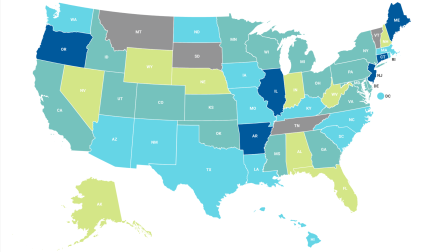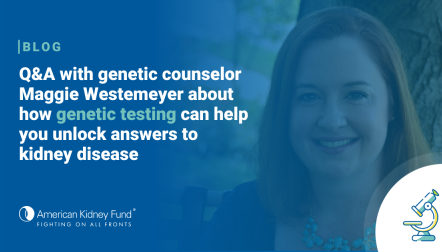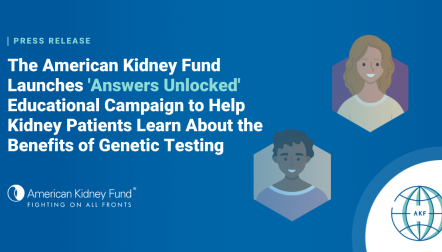
Blog post
How I am thriving with IgA nephropathy through healthy lifestyle changes

"What do you mean, I need a transplant again?"
I sat dumbfounded in my kidney doctor's office in early 2016, where I had sat hundreds of times before. I took the meds, I attended the appointments, I did all the things. I mean, I even went to the gym – what more could you want? I couldn't believe that despite my best efforts, my immune system had managed to destroy my native kidneys 10 years prior and now had destroyed my kidney transplant, too. I knew I did not want dialysis; I knew I would do what it took to get another transplant. And I knew I was going to research and learn ways to preserve and protect my second transplant even more. I am a journalist by trade, research is what I do!
I will tell you all about what I discovered, and how it's going. But first, let me tell you how we even got to this conversation.
In 2002, when I was 16 years old, I was surprised to see my urine blood red when I went to the bathroom. We rushed to the emergency room where after many blood tests, all we were told was that I wasn't pregnant and to follow up with my pediatrician. Thankfully, my doctor knew something was wrong and ordered a lot of tests. She saw my creatinine levels (the amount of waste products in my blood) were not normal and referred me to a pediatric nephrologist who got me in for a kidney biopsy in a week. The result: I was diagnosed with IgA nephropathy (IgAN).
This condition is an autoimmune disorder in which my immune system attacks my kidneys, "scarring them" until they could no longer function. There are two types of this illness: a typical and a more aggressive form, and I, of course, had the aggressive one. At that point, I had about 50% kidney function, and this dropped to 20% four years later, by 2006. Fortunately, my aunt volunteered to be my living kidney donor, and she was a match. The surgery went well, and she is doing great.
I did well for about three years, which is when the illness returned on the transplant. We tried aggressive steroids, both oral and IV. We even tried a form of chemotherapy like the ones used for cancer patients. We put the disease in remission four times in six years, but it kept returning. By 2016, my first transplant was failing.
Which brings us back to the scene in my doctor's office.
After my doctor told me I needed a second kidney transplant, my friends and I built a website and launched a social media campaign to find me another one. Several volunteers were tested to see if they could donate and, in the end, the best match was a friend of a friend. Six years later after receiving that transplant, I'm doing things a bit differently this time, and I am feeling healthier than I have since before the first transplant.
Doing things differently was easier said than done, though. Living with IgA nephropathy can be a struggle, not the least of which is the difficulty I have experienced with losing weight, made even more complicated by having been on steroids for more than 20 years. However, while I started to get prediabetes from steroids as well, in 2022, I have walked myself back below the prediabetic range for my blood sugars. How? I believe it is all about nutrition. It's true what they say, "You can't outrun a poor eating pattern."
Through consulting with my healthcare team, I have adjusted my approach to eating in ways that I find have made a difference in my health stability, energy and how I generally feel. Here are the adjustments I made that worked for me:
1. Eliminating binge eating.
As a way of handling depression related to my kidney disease fight, food was my comfort, and I overate a lot. I worked in therapy, with my husband and through workbooks – and by measuring all my food – to learn what makes up a "normal" portion.
2. Following a plant-dominant food plan.
I am not saying what kind of food plan to you need to follow. The best thing you can do is your own research and have thorough discussions with doctors. Involve both your primary care and specialists in this discussion and talk to a renal dietitian. The best ones I have found in online communities, but help is out there to learn more about your specific body.
3. Eating all meals and snacks out of a plate or bowl of some sort.
With all the responsibilities of life and kidney failure, it's easy to grab and go. But I have found sitting down to eat makes me accountable. It helps me think about if I am making the best decision to enjoy my body and helps me appreciate the taste of what I'm eating. Paper plates count!
4. Planning my meals ahead of time.
To do this, I keep breakfast very similar, mix up my dinners for variety and make extra dinner food to use for lunches the next day. My favorite breakfast is Greek yogurt or oats, topped with some sort of berry or banana and some granola. I find this keeps me full for several hours.
5. Cooking from scratch.
It sounds daunting, but to help find recipes, I use a recipe-planning site (there are many options out there, including the American Kidney Fund's Kidney Kitchen®)! The more you practice, the faster it gets. Take the time to learn about spices, and you would be amazed how delicious food on your eating plan can be. I view it as time for me to relax and practice a skill that is very different from the rest of day-to-day life. And yes, even a small portion of pasta, frozen veggies, canned tomato sauce and some tofu counts as a home-cooked meal! I would never have cooked if I didn't have kidney disease, but I would have been missing out. Now, cooking is faster, healthier, and frankly tastier than what we get at most restaurants!
6. Finding pre-made frozen meals to keep in our freezer for when cooking doesn't happen.
This is more of a sodium (salt) hit, and I try to pair it with a handful of nuts or some fruit, but it helps keep me away from fast food. I also find a good selection at my grocery store near the chillers for tofu and tempeh. Just be sure to check the labels to make sure they fit your nutrition requirements! And remember that processed plant-based meat substitutes often have even more sodium than their meat counterparts.
7. Coming up with fast food options that fulfill my plan as much as possible for if I get stuck.
If I don't have a backup frozen meal, I have a default order for Subway, and yes, McDonalds, so I don't get tempted into worse choices when I am out and about. I find it kind of fun to find the best combinations for me ahead of time! AKF's Guide to Dining Out provides tips to help you make healthy choices for your next meal out.
8. Creating a keystone habit.
I learned this from my medical exercise trainer (like a personal trainer, but for those of us with chronic illnesses, and those who are past physical therapy but not yet ready for a personal trainer). The idea is if you want to create a new habit (taking more time to pick/prepare healthy-for-me meals), you attach it – or "key it" – to something fun. I really enjoy fashion, so part of my morning routine is carefully picking out my outfit, down to shoes, nail polish and accessories. Once I'm put together, I feel I am continuing to treat myself right by taking the time to sit down and eat a healthy breakfast.
Again, these are lifestyle adjustments that are working well for me. It is important to consult with your healthcare team to find the ones that work best for you. There are also numerous resources available to help you navigate IgA nephropathy on both the IgA Nephropathy Foundation's and the American Kidney Fund's (AKF) websites – including The IgAN Cookbook,Cukebook.org and AKF's Kidney Kitchen®, which all have recipes to help you follow your kidney-friendly food and fluid plan.
Hopefully, these tips and resources will make it less likely we will have to hear that we need another transplant.





